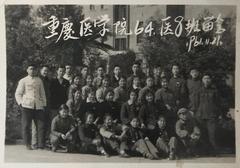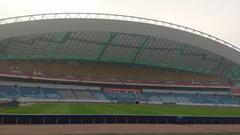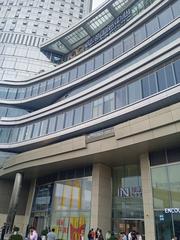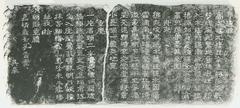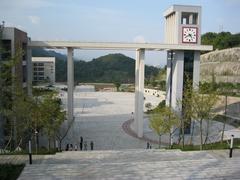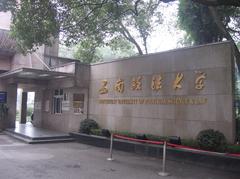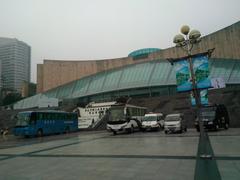Xiaonanya Railway Station Visiting Hours, Tickets, and Travel Guide in Chongqing
Date: 04/07/2025
Introduction
Xiaonanya Railway Station, located in the Jiangjin District of Chongqing, is a cornerstone of western China’s logistics infrastructure and a pivotal node in the New International Land-Sea Trade Corridor (ILSTC). This advanced inland freight terminal seamlessly integrates rail, road, and river transport, underpinning Chongqing’s emergence as a major logistics gateway for trade between China and Southeast Asia, South Asia, and Europe. Although Xiaonanya does not handle regular passenger services, its cutting-edge facilities, strategic connections, and role in international trade make it an essential point of interest for logistics professionals, travelers, and those intrigued by China’s economic development (iChongqing, 2025; China Railway, 2023).
This comprehensive guide details Xiaonanya’s history, infrastructure, operational innovations, visitor information, transport options, and nearby cultural sites—offering essential resources for planning your visit to Chongqing and understanding the station’s regional significance (Living Nomads, 2023; FreshPlaza, 2024).
Table of Contents
- Xiaonanya Railway Station at a Glance
- Origins and Strategic Context
- Development and Modernization
- Role in the New International Land-Sea Trade Corridor (ILSTC)
- Major Milestones and Freight Growth
- Technology and Operational Innovations
- Visitor Information and Accessibility
- Economic and Regional Impact
- Frequently Asked Questions (FAQ)
- Transportation and Travel Options
- Exploring Nearby Attractions and Cultural Sites
- Practical Tips for Visitors
- Summary and Future Prospects
- References and Further Reading
Xiaonanya Railway Station at a Glance
Xiaonanya Railway Station (小南垭站) is situated in the thriving Jiangjin District, acting as a major inland logistics hub supporting Chongqing’s industrial base and serving as a vital gateway for cross-border trade, especially with ASEAN countries. Its proximity to Luohuang Port Industry City enables seamless rail-water intermodal transfers, making it a model for inland freight handling in China.
Origins and Strategic Context
Xiaonanya’s rise is closely linked to the expansion of the ILSTC, a flagship initiative designed to boost connectivity between western China and international markets via multimodal transport. Situated near the Luohuang Port, Xiaonanya integrates with the Chuanqian Railway, connecting Chongqing to Guiyang, and further links to the Yangtze River Economic Belt and Belt and Road Initiative routes (China Railway).
Development and Modernization
Originally constructed in 1960, Xiaonanya has evolved from a modest fourth-class station into a sophisticated logistics hub. Major developments include:
- 1970: Dedicated 7.3 km rail line to Luohuang Port, enabling efficient rail-water transfer.
- 2014–2018: Expansion into the Luohuang Railway Comprehensive Logistics Hub, covering 2.4 km², with advanced container yards and freight lines.
- 2018 Onwards: Integration of digital tracking, expanded intermodal transfer points, and enhanced customs clearance zones (Wikiwand).
By 2024, Xiaonanya had become a primary departure and arrival site for ILSTC trains, equipped to handle diverse cargo, including perishables via state-of-the-art cold chain facilities (iChongqing, 2024).
Role in the New International Land-Sea Trade Corridor (ILSTC)
As a key hub in the ILSTC, Xiaonanya enables:
- Multimodal Integration: Direct links to river ports and highways for efficient cargo transfer.
- International Freight Operations: Launch point for cross-border trains to Laos, Thailand, Malaysia, and Myanmar. In 2024, the first China-Myanmar cross-border rail and highway train departed Xiaonanya, reducing transit times by about 20 days (NDRC, 2023).
- Cold Chain Logistics: Specialized facilities for perishable goods. February 2024 saw the arrival of the first cold chain train from Laos, carrying 200 tons of bananas, and subsequent lemon exports to Thailand (iChongqing, 2024).
Major Milestones and Freight Growth
- 2023–2024: Launch of cross-border rail and highway trains, including the landmark China-Laos-Thailand-Malaysia corridor (iChongqing, 2024).
- Freight Volume: Chongqing transported over 249,000 TEUs via ILSTC in 2024, a 39% increase year-on-year, with Xiaonanya as a major contributor (iChongqing, 2025).
Technology and Operational Innovations
- Digital Tracking: Real-time monitoring for optimized scheduling and security.
- Customs Efficiency: Inspection times reduced to as little as four hours, even during busy periods.
- Cold Chain Facilities: Temperature-controlled storage and refrigerated containers for perishables (iChongqing, 2024).
Visitor Information and Accessibility
Visiting Hours & Access
- Freight Operations Only: Xiaonanya does not operate passenger services and is not open for general public visits.
- Special Events: Designated viewing areas are available during official ceremonies or pre-arranged tours. Contact local tourism offices or logistics companies for details.
Accessibility & Travel Tips
- Location: Easily accessible from central Chongqing via local transport and taxis.
- Nearby Attractions: Visitors can explore Luohuang Port Industry City and Jiangjin District’s cultural sites.
Photographic Spots
- Exterior Views: Modern architecture and adjacent river-port scenery can be photographed from public areas. Early morning and late afternoon offer optimal lighting.
Economic and Regional Impact
Xiaonanya has transformed Jiangjin District and Chongqing by:
- Accelerating regional and international trade
- Creating jobs and attracting logistics firms
- Strengthening ties with ASEAN and supporting local industries through efficient import/export handling (China Railway)
Frequently Asked Questions (FAQ)
Q: Can I visit Xiaonanya Railway Station as a tourist?
A: Only during special events or pre-arranged tours. The station primarily handles freight.
Q: Are there passenger train services?
A: No, Xiaonanya is freight-only. Use Chongqing North or West stations for passenger services.
Q: What industries benefit most?
A: Manufacturing, agriculture, chemicals, and machinery sectors.
Q: How can I learn more about Xiaonanya’s operations?
A: Local tourism offices and logistics firms can provide information; public events are occasionally held.
Transportation and Travel Options
Rail Connectivity
- Freight Services: Xiaonanya is a major freight node, with direct links to Luohuang Port and ILSTC routes.
- Passenger Rail: Use Chongqing North, West, or East stations for high-speed and intercity trains (China Highlights).
Chongqing Metro System
- Coverage: Six lines, 264 km; plans for 18 lines by 2035 (MetroEasy).
- Nearest Metro: Jiangjin District is served by Line 5, with ongoing expansions.
Bus and Taxi Services
- Buses: Connect Xiaonanya to central Chongqing, fares 2–5 yuan.
- Taxis: Start at ~10 yuan; longer rides to the city center or airport range from 80–200 yuan.
Airport Access
- Chongqing Jiangbei International Airport: 60 km northeast, accessible via metro Line 5 and transfers, or by airport shuttle/private car.
Exploring Nearby Attractions and Cultural Sites
Jiangjin District Highlights
- Simian Mountain (Simianshan): Lush forests, waterfalls, and hiking trails, 50 km away.
- White Crane Ridge Underwater Museum: Ancient stone carvings; regional rail and bus access.
Chongqing Urban Attractions
- Hongya Cave: Traditional stilt houses and night markets (TravelChinaGuide).
- Ciqikou Ancient Town: Historic streets and teahouses (Living Nomads).
- Liziba Station: Iconic monorail passing through a building.
- Nanbin Road Bell Tower: Landmark with scenic river views.
Natural Wonders
- Wulong Karst Geological Park: UNESCO World Heritage site, 130 km from Chongqing.
- Dazu Rock Carvings: Ancient religious sculptures, 167 km away.
Local Cuisine and Nightlife
- Hot Pot and Spicy Noodles: Sample local flavors in Jiangjin’s eateries.
- Two Rivers Night Cruise: Scenic city skyline views (TravelChinaGuide).
Practical Tips for Visitors
- Language: English is limited; translation apps are helpful.
- Payment: Mobile payment (WeChat Pay, Alipay) is widely accepted; cash is also common.
- Weather: Humid subtropical; summers are hot and humid, winters mild.
- Accessibility: Most metro stations and main attractions are accessible.
Summary and Future Prospects
Xiaonanya Railway Station exemplifies Chongqing’s transformation into a global logistics powerhouse. Its advanced infrastructure, strategic connections, and integration into the ILSTC have accelerated regional trade and economic growth, particularly with Southeast Asia. Although not a passenger hub, Xiaonanya offers valuable insights for those interested in modern industrial logistics and regional development. Ongoing investments and technological upgrades will further cement its role as a world-class inland freight hub (iChongqing, 2025; China Railway, 2023).
References and Further Reading
- iChongqing, 2025: 390 TEU ILSTC Shipment Sets Off
- China Railway, 2023: Xiaonanya as a Key Freight Hub
- Living Nomads, 2023: Chongqing Travel Blog
- FreshPlaza, 2024: First ILSTC China-Laos-Thailand Cold Chain Train
- MetroEasy, 2025: Chongqing Metro System Expansion
- NDRC, 2023: Cross-border Rail and Highway Intermodal Train Launch
- China Highlights, 2023: Chongqing Transportation Overview
- Wikiwand: Xiaonanya Railway Station Background
- TravelChinaGuide: Chongqing Attractions
For up-to-date information, interactive maps, and exclusive travel content, download the Audiala app. Explore more guides on Chongqing’s transportation and historical sites to make the most of your visit.

